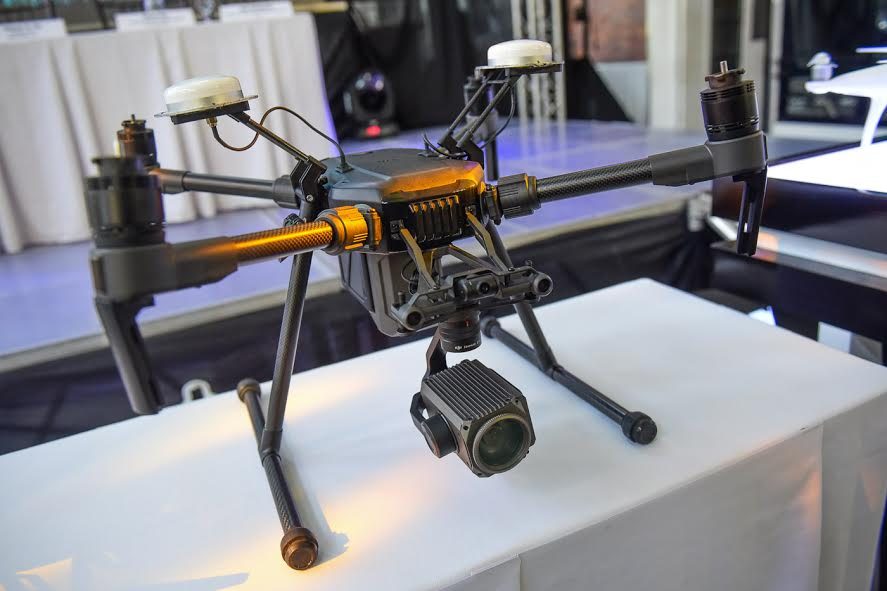
Upgrade to High-Speed Internet for only ₱1499/month!
Enjoy up to 100 Mbps fiber broadband, perfect for browsing, streaming, and gaming.
Visit Suniway.ph to learn

MATRICE 200. In this file photo, this model from DJI is designed for heavy duty use such as search and rescue, power line inspection, and agricultural deployment to name some, on display at a DJI event in the Philippines in 2017
File photo by Alecs Ongcal/Rappler
While Grab’s service would appear to be focused on speeding up urban commercial deliveries, other successful use cases found in other parts of the world — medical supply delivery, and delivery to remote islands — certainly sound like things that would be very helpful in the Philippines
MANILA, Philippines – Superapp Grab, Megaworld, and government agencies Department of Information and Communications Technology plus Department of Transportation on Tuesday, June 24 announced quite an ambitious project: the potential use of drones in deliveries.
The partnership announced the launch of a pilot study to be tested in two Megaworld properties in Manila, involving select consumers and merchant partners. The study will gauge whether unmanned aerial vehicles will indeed result in faster order fulfillment “by sidestepping traffic bottlenecks.”
Such a system may also have benefits in reducing road traffic caused by traditional delivery vehicles.
The delivery model that the project is testing appears to assign the drone to a “middle mile” function: Drones will pick up items from a primary delivery hub, fly off to “dedicated drone landing stations” where Grab delivery riders will pick up the item and fulfill the last mile to the customer.
It’s an innovation that this public-private partnership hopes, primarily, to get items even faster to the end user.
While it’s the first project of its kind in the Philippines, the idea of using drones for commercial deliveries isn’t.
Amazon first announced something like it in December 2013, called Amazon Prime Air. The company aimed for a 2015 launch, but missed that — by many years. It finally launched in 2022 in the US but is still very limited, currently operating in just 2 cities in the US, with plans to slowly expand in Europe. While Amazon has been trying to reduce the cost, 2022 projections for 2025 still put the number at $63 for drone delivery.
Here’s a promotional video from Amazon:

Airspace regulations were also something that slowed down the fast deployment for drones.
But Amazon differs from the Grab pilot in one crucial way: the former is attempting to make the deliveries direct to the customer unlike the latter’s proposed middle-mile system.
A 2024 editorial by Commercial UAV News argues that Amazon’s last-mile vision is not working, with the top reason being strict airspace regulations in the heavily populated residential areas that the company seeks to deliver to.
It says that the reason that commercial drones are working in countries other than the US is because companies there are targeting different parts of the distribution chain.
Aerialoop in Ecuador is using drones to fulfill the middle-mile.
Speedbird in Brazil, Scotland, Israel, Singapore, and 6 other countries are using drones to complete deliveries in hard-to-reach areas such as those in the Amazon, and remote islands — areas where unmanned aerial vehicles won’t receive much public opposition.
Zipline in Africa, meanwhile, focuses on the delivery of medical supplies that are then parachuted into regions that need them, rather than the commercial parcels that we’re most familiar with. The use of drones to deliver medical supplies, in fact, has been one of the strongest use cases for the technology, with many test programs around the world for it.
Aside from Africa’s Zipline, the World Economic Forum’s Medicine from the Sky initiative presents an ideal example.
The World Economic Forum writes, “One of the most striking outcomes has been the dramatic reduction in delivery times. Journeys that once took eight hours by ground transport have been slashed to just 22 minutes, as the drones fly directly to the customer rather than having to navigate dangerous mountain roads. This has cut emergency response times, saving lives in critical situations.
“Flying medicines to patients also cuts out the need for patients in isolated areas to attend clinics to access drugs. In mountainous regions, such journeys can take days and cost thousands of rupees.”
From these few examples, Grab’s middle-mile system may circumvent the problems that Amazon’s last-mile program has seen through the years.
And while Grab’s service would appear to be focused on speeding up urban commercial deliveries, other successful use cases found in other parts of the world — medical supply delivery, and delivery to remote islands — certainly sound like things that would be very helpful in the Philippines too for the right startup or company to pursue in the future.
In fact, Grab seems to be hinting at the usefulness of drones in a country made up of islands: “The Philippine geography, marked by its archipelagic layout and growing reliance on e-commerce, presents an ideal testbed for drone-based logistics.”
Grab Philippines managing director Ronald Roda, says, “This pilot is an opportunity for us to learn and understand how drone deliveries might work in the Philippine context, from dense urban neighborhoods to underserved areas. We’re optimistic about the insights this pilot will bring, and we look forward to co-creating solutions that benefit everyone in the ecosystem — from consumers, merchant-partners, and our delivery-partners.” – Rappler.com

 5 hours ago
2
5 hours ago
2



